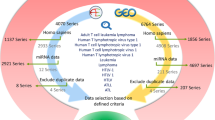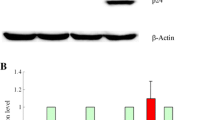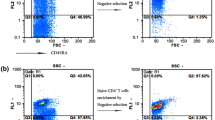Abstract
This study aimed to identify target genes regulated by KSHV miRNAs in KSHV-infected lymphoma cells. Original Ago HITS-CLIP data of BC-3 and BCBL-1 cell lines were downloaded from SRA database in NCBI, including mRNA and miRNA samples. The raw mRNA reads were mapped into human reference genome hg19 via TopHat for read alignment. PCR duplicates were removed via the SAM tool and the peaks of reads were analyzed via Cufflinks. For miRNA data, the raw data were mapped to the mature miRNA sequences based on miRBase via Bowtie. Peak intersection was computed by using intersectBed in BEDtools. Then, the mature miRNA seeds were identified and then were aligned with 3’ UTR merged peaks. The regulationships of miRNAs and their corresponding genes were analyzed based on the signal of RNA-induced silencing complex. Totally, 7 KSHV-related genes regulated by KSHV miRNAs were identified, including IPO5, EDA, NT5C3, WSB1, KCNS1, PRAM1 and MTRNR2L6. Among them, EDA, MTRNR2L6 and IPO5 were regulated by multiple KSHV miRNAs, such as kshv-miR-K12-1-5p, kshv-miR-K12-4-3p and kshv-miR-K12-3-5p, respectively. Furthermore, expression of kshv-miR-K12-1-5p and kshv-miR-K12-3-5p in BCBL-1 cell line were lower than that in BC-3 cell line, conversely, expression of kshv-miR-K12-4-3p in BCBL-1 cell line were higher than that in BC-3 cell line. In conclusion, potential target genes regulated by KSHV miRNAs in KSHV-infected lymphoma cells might play key roles in the nosogenesis of this disease. These findings might provide the basis for deep understanding of KSHV-infected tumors and further molecular experiments.



Similar content being viewed by others
References
Cesarman E, Chang Y, Moore PS, Said JW, Knowles DM (1995) Kaposi’s sarcoma–associated herpesvirus-like DNA sequences in AIDS-related body-cavity–based lymphomas. N Engl J Med 332:1186–1191
Lin X, Li X, Liang D, Lan K (2012) MicroRNAs and unusual small RNAs discovered in Kaposi’s sarcoma-associated herpesvirus virions. J Virol 86:12717–12730
Gottwein E, Mukherjee N, Sachse C et al (2007) A viral microRNA functions as an orthologue of cellular miR-155. Nature 450:1096–1099
Hansen A, Henderson S, Lagos D et al (2010) KSHV-encoded miRNAs target MAF to induce endothelial cell reprogramming. Genes Dev 24:195–205
Gottwein E, Cullen BR (2010) A human herpesvirus microRNA inhibits p21 expression and attenuates p21-mediated cell cycle arrest. J Virol 84:5229–5237
Haecker I, Gay LA, Yang Y et al (2012) Ago HITS-CLIP expands understanding of Kaposi’s sarcoma-associated herpesvirus miRNA function in primary effusion lymphomas. PLoS Pathog 8:23
Trapnell C, Pachter L, Salzberg SL (2009) TopHat: discovering splice junctions with RNA-Seq. Bioinformatics 25:1105–1111
Li H, Handsaker B, Wysoker A et al (2009) The sequence alignment/map format and SAMtools. Bioinformatics 25:2078–2079
Trapnell C, Williams BA, Pertea G et al (2010) Transcript assembly and quantification by RNA-Seq reveals unannotated transcripts and isoform switching during cell differentiation. Nat Biotechnol 28:511–515
Langmead B, Trapnell C, Pop M, Salzberg SL (2009) Ultrafast and memory-efficient alignment of short DNA sequences to the human genome. Genome Biol 10:R25
Quinlan AR, Hall IM (2010) BEDTools: a flexible suite of utilities for comparing genomic features. Bioinformatics 26:841–842
Da Wei Huang BTS, Lempicki RA (2008) Systematic and integrative analysis of large gene lists using DAVID bioinformatics resources. Nat Protoc 4:44–57
Ashburner M, Ball CA, Blake JA et al (2000) Gene Ontology: tool for the unification of biology. Nat Genet 25:25–29
Punj V, Matta H, Chaudhary PM (2010) X-linked ectodermal dysplasia receptor is downregulated in breast cancer via promoter methylation. Clin Cancer Res 16:1140–1148
Keller SA, Schattner EJ, Cesarman E (2000) Inhibition of NF-κB induces apoptosis of KSHV-infected primary effusion lymphoma cells. Blood 96:2537–2542
De Oliveira DE, Ballon G, Cesarman E (2010) NF-κB signaling modulation by EBV and KSHV. Trends Microbiol 18:248–257
Aggarwal BB (2000) Tumour necrosis factors receptor associated signalling molecules and their role in activation of apoptosis, JNK and NF-κB. Ann Rheum Dis 59:i6–i16
Lei X, Bai Z, Ye F et al (2010) Regulation of NF-κB inhibitor IκBα and viral replication by a KSHV microRNA. Nat Cell Biol 12:193–199
Bodzioch M, Lapicka-Bodzioch K, Zapala B, Kamysz W, Kiec-Wilk B, Dembinska-Kiec A (2009) Evidence for potential functionality of nuclearly-encoded humanin isoforms. Genomics 94:247–256
Hashimoto Y, Niikura T, Tajima H et al (2001) A rescue factor abolishing neuronal cell death by a wide spectrum of familial Alzheimer’s disease genes and Aβ. Proc Natl Acad Sci U S A 98:6336–6341
Guo B, Zhai D, Cabezas E et al (2003) Humanin peptide suppresses apoptosis by interfering with Bax activation. Nature 423:456–461
Luciano F, Zhai D, Zhu X et al (2005) Cytoprotective peptide humanin binds and inhibits proapoptotic Bcl-2/Bax family protein BimEL. J Biol Chem 280:15825–15835
Skalsky RL, Samols MA, Plaisance KB et al (2007) Kaposi’s sarcoma-associated herpesvirus encodes an ortholog of miR-155. J Virol 81:12836–12845
Gorlich D, Mattaj IW (1996) Nucleocytoplasmic transport. Science 271:1513–1519
Author information
Authors and Affiliations
Corresponding author
Rights and permissions
About this article
Cite this article
Quan, L., Qiu, T., Liang, J. et al. Identification of Target Genes Regulated by KSHV miRNAs in KSHV-Infected Lymphoma Cells. Pathol. Oncol. Res. 21, 875–880 (2015). https://doi.org/10.1007/s12253-015-9902-2
Received:
Accepted:
Published:
Issue Date:
DOI: https://doi.org/10.1007/s12253-015-9902-2




